Seasonal Variations in the Thermal Stratification Responses and Water Quality of the Paldang Lake
Abstract
:1. Introduction
2. Materials and Methods
2.1. Study Site
2.2. Sampling and Water Quality Analysis Methods and Data Processing
2.3. Thermal Stratification Evaluation
2.4. Chemical Stratification Evaluation
3. Results and Discussion
3.1. Annual Variations in Meteorological, Hydrological Factors, and Water Temperature
3.2. Thermal Stratification Evaluation
3.3. Thermal and Chemical Stratification of Paldang Lake and Water Quality
4. Conclusions
Author Contributions
Funding
Data Availability Statement
Conflicts of Interest
References
- Imneisi, I.B.; Aydin, M. Water Quality Index (WQI) for Main Source of Drinking Water (Karaomak Dam) in Kastamonu City, Turkey. J. Environ. Anal. Toxicol. 2016, 6, 407. [Google Scholar] [CrossRef]
- Kong, D.S. Evaluating effect of density flow from upstream on vertical distribution of water quality at the Paldang Reservoir. J. Korea Soc. Water Environ. 2019, 35, 557–566. [Google Scholar]
- Szewczyk, M.; Tomczyk, P.; Wiatkowski, M. Water Management on Drinking Water Reservoirs in the Aspect of Climate Variability: A Case Study of the Dobromierz Dam Reservoir, Poland. Sustainability 2022, 16, 6478. [Google Scholar] [CrossRef]
- Martin, J.L.; McCutcheon, S.C. Hydrodynamics and Transport for Water Quality Modeling; CRC Press Inc.: New York, NY, USA, 1999; pp. 1–794. [Google Scholar]
- Yang, Y.; Colom, W.; Pierson, D.; Pettersson, K. Water column stability and summer phytoplankton dynamics in a temperate lake (Lake Erken, Sweden). Inland Waters 2016, 6, 499–508. [Google Scholar] [CrossRef]
- Nowlin, W.H.; Davies, J.M.; Nordin, R.N.; Mazumder, A. Effects of water level fluctuation and short-term climate variation on thermal and stratification regimes of a British Columbia reservoir and lake. Lake Reserv. Manag. 2004, 20, 91–109. [Google Scholar] [CrossRef]
- Ramón, C.L.; Hoyer, A.B.; Armengol, J.; Dolz, J.; Rueda, F.J. Mixing and circulation at the confluence of two rivers entering a meandering reservoir. Water Resour. Res. 2013, 49, 1429–1445. [Google Scholar] [CrossRef]
- Kim, J.M.; Park, J.D.; Noh, H.R.; Han, M.S. Changes of seasonal vertical water quality in Soyang and Paldang river-reservoir system. Korean J. Limnol. 2002, 35, 10–20. [Google Scholar]
- Kong, D.S. Limnological and ecological characteristics of a river-reservoir (Paldang), Korea. Korean J. Limnol. 1997, 30, 524–535. [Google Scholar]
- Park, H.K.; Byeon, M.S.; Choi, M.J.; Kim, Y.J. The effect factors on the growth of phytoplankton and the sources of organic matters in downstream of South-Han River. J. Korean Soc. Water Environ. 2008, 24, 556–642. [Google Scholar]
- Wetzel, R.G. Limnology: Lake and River Ecosystems, 3rd ed.; Academic Press: San Diego, CA, USA, 2001. [Google Scholar]
- Boyce, D.G.; Lewis, M.R.; Worm, B. Global phytoplankton decline over the past century. Nature 2010, 466, 591–596. [Google Scholar] [CrossRef]
- Moran, X.A.G.; Lopez-Urrutia, A.; Calvo-Diaz, A.; Li, W.K.W. Increasing importance of small phytoplankton in a warmer ocean. Glob. Chang. Biol. 2010, 16, 1137–1144. [Google Scholar] [CrossRef]
- Becker, V.; Caputo, L.; Ordóñez, J.; Marcé, R.; Armengol, J.; Crossetti, L.O.; Huszar, V.L.M. Driving factors of the phytoplankton functional groups in a deep Mediterranean reservoir. Water Res. 2010, 44, 3345–3354. [Google Scholar] [CrossRef]
- Chung, S.W.; Imberger, J.; Hipsey, M.R.; Lee, H.S. The influence of physical and physiological processes on the spatial heterogeneity of a Microcystis bloom in a stratified reservoir. Ecol. Model. 2014, 289, 133–149. [Google Scholar] [CrossRef]
- Elçi, Ş. Effects of thermal stratification and mixing on reservoir water quality. Limnology 2008, 9, 135–142. [Google Scholar] [CrossRef]
- Gelda, R.K.; Brooks, C.M.; Effler, S.W.; Auer, M.T. Interannual variations in nitrification in a hypereutrophic urban lake: Occurrences and implications. Water Res. 2000, 34, 1107–1118. [Google Scholar] [CrossRef]
- MacIntyre, S.; Fram, J.P.; Kushner, P.J.; Bettez, N.D.; O’Brien, W.J.; Hobbie, J.E.; Kling, G.W. Climate-related variations in mixing dynamics in an Alaskan arctic lake. Limnol. Oceanogr. 2009, 54, 2401–2417. [Google Scholar] [CrossRef]
- Paerl, H.W.; Paul, V.J. Climate change: Links to global expansion of harmful cyanobacteria. Water Res. 2012, 46, 1349–1363. [Google Scholar] [CrossRef]
- Zhang, H.; Richardson, P.A.; Belayneh, B.E.; Ristvey, A.; Lea-Cox, J.; Copes, W.E.; Moorman, G.W.; Hong, C. Characterization of water quality in stratified nursery recycling irrigation reservoirs. Agric. Water Manag. 2015, 160, 76–83. [Google Scholar] [CrossRef]
- Zhang, H.; Richardson, P.A.; Belayneh, B.E.; Ristvey, A.; Lea-Cox, J.; Copes, W.E.; Moorman, G.W.; Hong, C. Recycling irrigation reservoir stratification and implications for crop health and production. J. Am. Water Resour. Assoc. 2016, 52, 620–631. [Google Scholar] [CrossRef]
- Horne, A.J.; Goldman, R. Limnology, 2nd ed.; McGraw-Hill: New York, NY, USA, 1994. [Google Scholar]
- Idso, S.B. On the concept of lake stability. Limnol Ocean. 1973, 18, 681–683. [Google Scholar] [CrossRef]
- Schmidt, W. Uber die Temperatur- und Stabilitatsverhaltnisse von Seen. Geogr. Ann. 1928, 10, 145–177. [Google Scholar] [CrossRef]
- Hutchinson, G.E. Geography, physics and chemistry. In A Treatise on Limnology; Wiley: New York, NY, USA, 1957. [Google Scholar]
- Yu, H.; Tsuno, H.; Hidaka, T.; Jiao, C. Chemical and thermal stratification in lakes. Limnology 2010, 11, 251–257. [Google Scholar] [CrossRef]
- Dunnivant, F.M. An integrated limnology, microbiology and chemistry exercise for teaching summer lake stratification, nutrient consumption and chemical thermodynamics. Am. Biol. Teach. 2006, 68, 424–427. [Google Scholar] [CrossRef]
- Ryu, I.; Yu, S.; Chung, S. Characterizing Density Flow Regimes of Three Rivers with Different Physicochemical Properties in a Run-Of-The-River Reservoir. Water 2020, 12, 717. [Google Scholar] [CrossRef]
- Kling, G.W. Comparative transparency, depth of mixing, and stability of stratification in lakes of Cameroon. West Africa. Limnol. Oceanogr. 1988, 33, 27–40. [Google Scholar] [CrossRef]
- Ferris, J.M.; Burton, H.R. The annual cycle of heat content and mechanical stability of hypersaline Deep Lake, Vestfold Hills, Antarctica. Hydrobiologia 1988, 165, 115–128. [Google Scholar] [CrossRef]
- Coats, R.; Losada, J.P.; Schladow, G.; Richards, R.; Goldman, C. The Warming of lake Tahoe. Clim. Chang. 2006, 76, 121–148. [Google Scholar] [CrossRef]
- Read, J.S.; Hamilton, D.P.; Jones, I.D.; Muraoka, K.; Winslowd, L.A.; Kroiss, R.; Wu, C.H.; Gaiser, E. Derivation of lake mixing and stratification indices from high-resolution lake buoy data. Environ. Model. Softw. 2011, 26, 1325–1336. [Google Scholar] [CrossRef]
- Winder, M.; Schindler, D.E. Climatic effects on the phenology of lake processes. Glob. Chang. Biol. 2004, 10, 1844–1856. [Google Scholar] [CrossRef]
- Yoon, S.W.; Park, G.Y.; Chung, S.W.; Kang, B.S. Projection of the Climate Change Effects on the Vertical Thermal Structure of Juam Reservoir. J. Korean Soc. Water Environ. 2014, 30, 491–502. [Google Scholar] [CrossRef]
- Sahoo, G.B.; Forrest, A.L.; Schladow, S.G.; Reuter, J.E.; Coats, R.; Dettinger, M. Climate change impacts on lake thermal dynamics and ecosystem vulnerabilities. Limnol. Oceanogr. 2016, 61, 496–507. [Google Scholar] [CrossRef]
- Bertone, E.; Stewart, R.A.; Zhang, H.; O’Halloran, K. Analysis of the mixing processes in the subtropical Advancetown Lake, Australia. J. Hydrol. 2015, 522, 67–79. [Google Scholar] [CrossRef]
- Kim, Y.T.; Park, M.; Kwon, H.H. Spatio-Temporal Summer Rainfall Pattern in 2020 from a Rainfall Frequency Perspective. Korea Soc. Disaster Secur. 2020, 13, 93–104. [Google Scholar]
- Hwang, S.J.; Kim, K.H.; Park, C.H.; Seo, W.B.; Choi, B.G.; Eum, H.S.; Park, M.H.; Noh, H.R.; Sim, Y.B.; Shin, J.K. Hydro-meteorological Effects on Water Quality Variability in Paldang Reservoir, Confluent Area of the South-Han River-North-Han River-Gyeongan Stream, Korea. Korean Soc. Limnol. 2016, 49, 354–374. [Google Scholar] [CrossRef]
- Jung, S.; Shin, M.; Kim, J.; Eum, J.; Lee, Y.; Lee, J.; Choi, Y.; You, K.; Owen, J.; Kim, B. The effects of Asian summer monsoons on algal blooms in reservoirs. Inland Waters 2016, 6, 406–413. [Google Scholar] [CrossRef]
- Soares, M.C.S.; Marinho, M.M.; Huszar, V.L.M.; Branco, C.W.C.; Azevedo, S.M.F.O. The effects of water retention time and watershed features on the limnology of two tropical reservoirs in Brazil. Lakes Reserv. Res. Manag. 2008, 13, 257–269. [Google Scholar] [CrossRef]
- Mahanty, M.M.; Mohanty, P.K.; Pattnaik, A.K.; Panda, U.S.; Pradhan, S.; Samal, R.N. Hydrodynamics, temperature/salinity variability and residence time in the Chilika lagoon during dry and wet period: Measurement and modeling. Cont. Shelf Res. 2016, 125, 28–43. [Google Scholar] [CrossRef]
- Edinger, J.E.; Duttweiler, D.W.; Geyer, J.C. The response of water temperature to meteorological conditions. Water Resour. Res. 1968, 4, 1137–1145. [Google Scholar] [CrossRef]
- Kędra, M.; Wiejaczka, L. Disturbance of water-air temperature synchronisation by dam reservoirs. Water Environ. J. 2016, 30, 31–39. [Google Scholar] [CrossRef]
- Kedra, M.; Wiejaczka, L. Climatic and dam-induced impacts on river water temperature: Assessment and management implications. Sci. Total Environ. 2018, 626, 1474–1483. [Google Scholar] [CrossRef]
- Kheiri, G.; Pabalan, R.; Duka, M.A.; Azhikodan, G.; Yokoyama, K. Factors contributing to the minimum water column stability and timing of the winter turnover in the Ogouchi reservoir. J. Environ. Manag. 2024, 365, 121537. [Google Scholar] [CrossRef] [PubMed]
- Olsson, F.; Mackay, E.B.; Barker, P.; Davies, S.; Hall, R.; Spears, B.; Exley, G.; Thackeray, S.J.; Jones, I.D. Can reductions in water residence time be used to disrupt seasonal stratification and control internal loading in a eutrophic monomictic lake? J. Environ. Manag. 2022, 304, 114169. [Google Scholar] [CrossRef] [PubMed]
- Straskraba, M.; Hocking, G. The effect of theoretical retention time on the hydrodynamics of deep river valley reservoirs. Int. Rev. Hydrobiol 2002, 87, 61–83. [Google Scholar] [CrossRef]
- Noori, R.; Berndtsson, R.; Adamowski, J.F.; Abyaneh, M.R. Temporal and depth variation of water quality due to thermal stratification in Karkheh Reservoir, Iran. J. Hydrol. Reg. Stud. 2018, 19, 279–286. [Google Scholar] [CrossRef]
- Noori, R.; Ansari, E.; Bhattarai, R.; Tang, Q.; Aradpour, S.; Maghrebi, M.; Haghighi, A.T.; Bengtsson, L.; Kløve, B. Complex dynamics of water quality mixing in a warm mono-mictic reservoir. Sci. Total Environ. 2021, 777, 146097. [Google Scholar] [CrossRef]
- Beutel, M.W. Hypolimnetic Anoxia and Sediment Oxygen Demand in California Drinking Water Reservoirs. Lake Reserv. Manag. 2003, 19, 208–221. [Google Scholar] [CrossRef]
- Song, E.S.; Cho, K.A.; Shin, Y.S. Exploring the Dynamics of Dissolved Oxygen and Vertical Density Structure of Water Column in the Youngsan Lake. J. Environ. Sci. Int. 2015, 24, 163–174. [Google Scholar] [CrossRef]
- Park, H.K.; Lee, U.H.; Jung, D.I. Organic Carbon Budget during Rainy and Dry Period in Paldang Reservoir. Korean J. Limnol. 2004, 37, 272–281. [Google Scholar]
- Leon, J.G.; Beamud, S.G.; Temporetti, P.F.; Atencio, A.G.; Diaz, M.M.; Pedrozo, F.L. Stratification and residence time as factors controlling the seasonal variation and the vertical distribution of chlorophyll-a in a subtropical irrigation reservoir. Int. Rev. Hydrobiol. 2016, 101, 36–47. [Google Scholar] [CrossRef]
- Staehr, P.A.; Jensen, K.S. Seasonal changes in temperature and nutrient control of photosynthesis, respiration and growth of natural phytoplankton communities. Freshw. Biol. 2006, 51, 249–262. [Google Scholar] [CrossRef]
- Kim, J.M.; Atique, U.; Mamun, M.; An, K.G. Long-Term Interannual and Seasonal Links between the Nutrient Regime, Sestonic Chlorophyll and Dominant Bluegreen Algae under the Varying Intensity of Monsoon Precipitation in a DrinkingWater Reservoir. Int. J. Environ. Res. Public Health 2021, 18, 2871. [Google Scholar] [CrossRef] [PubMed]
- Jargal, N.; An, K.G. Seasonal and interannual responses of blue-green algal taxa and chlorophyll to a monsoon climate, flow regimes, and N:P ratios in a temperate drinkingwater reservoir. Sci. Total Environ. 2023, 896, 165306. [Google Scholar] [CrossRef] [PubMed]

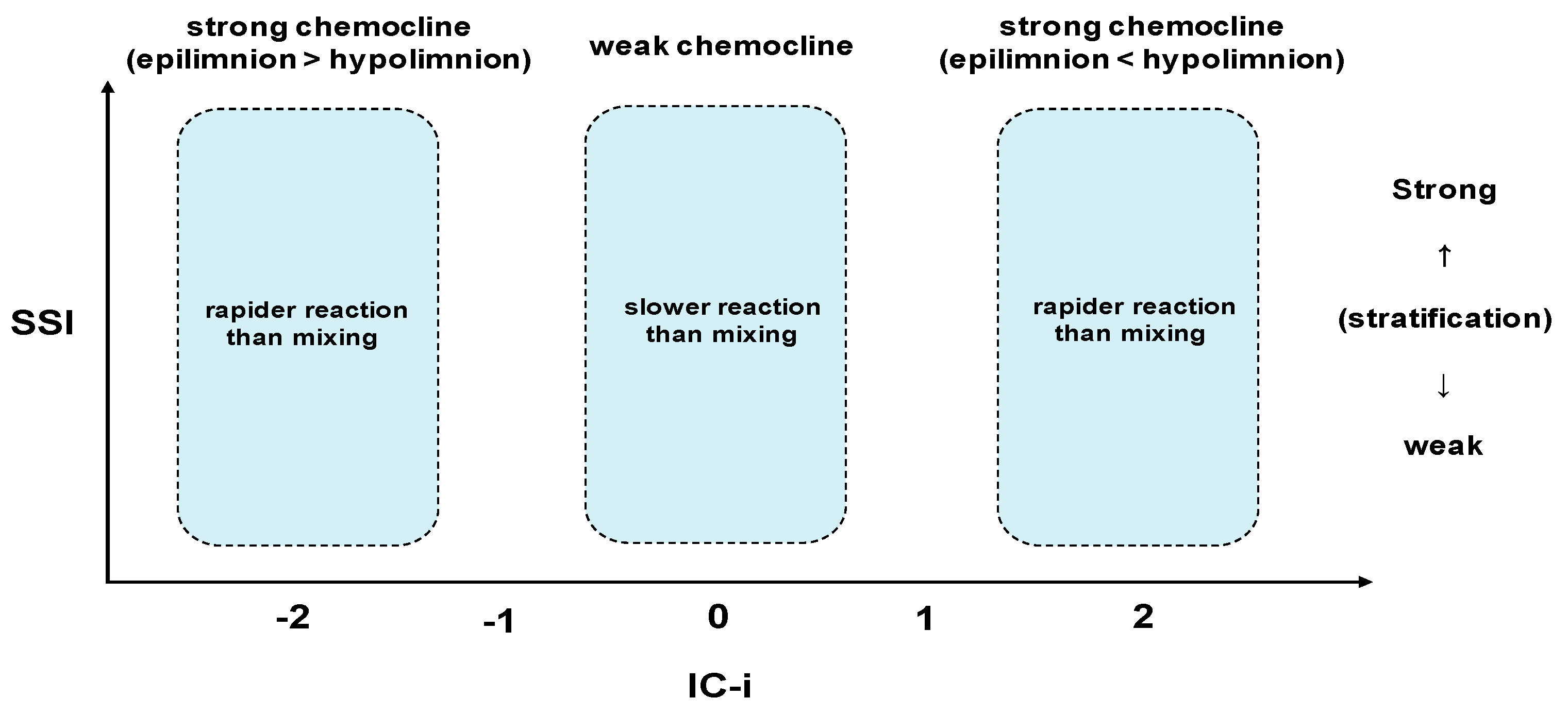


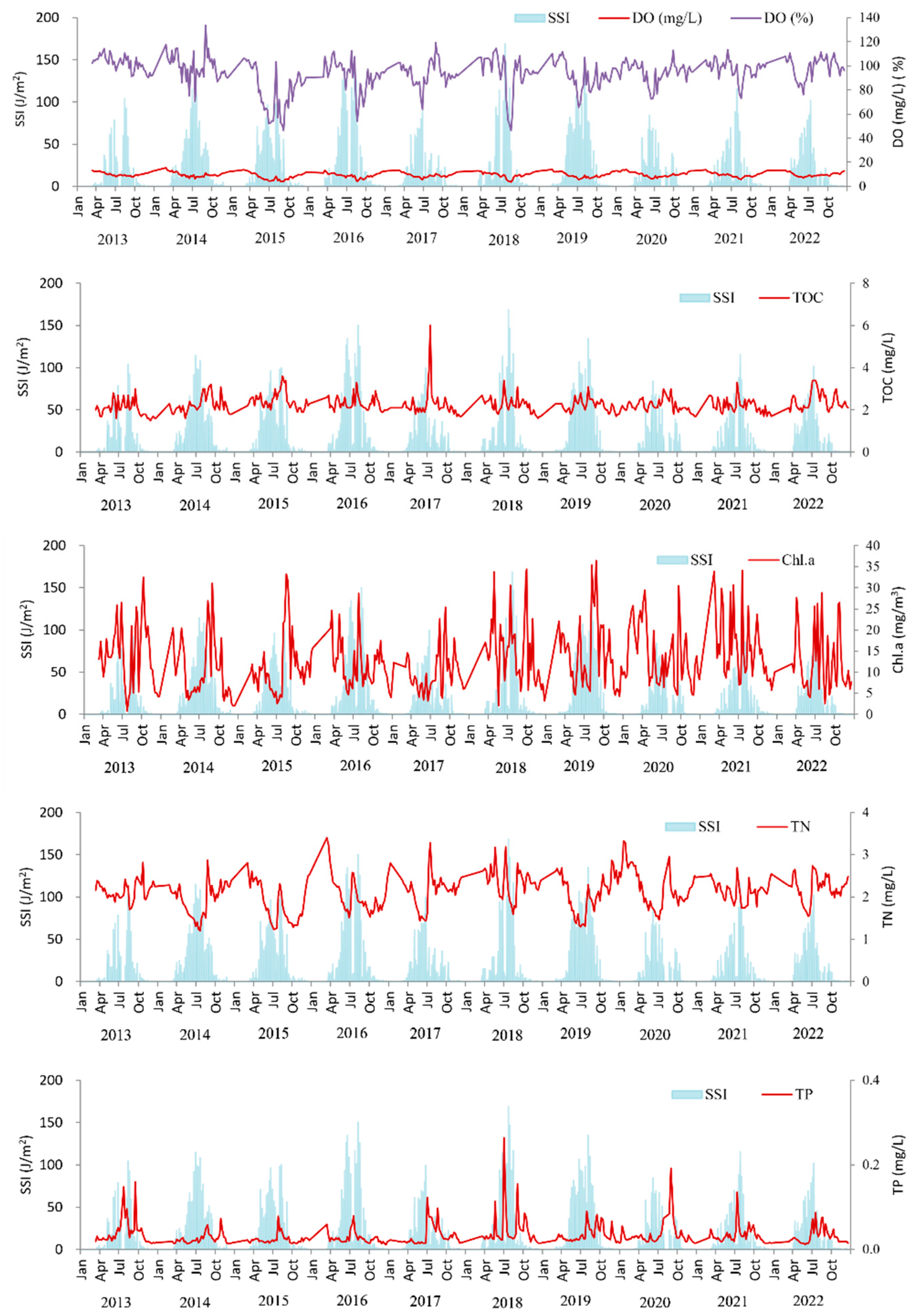
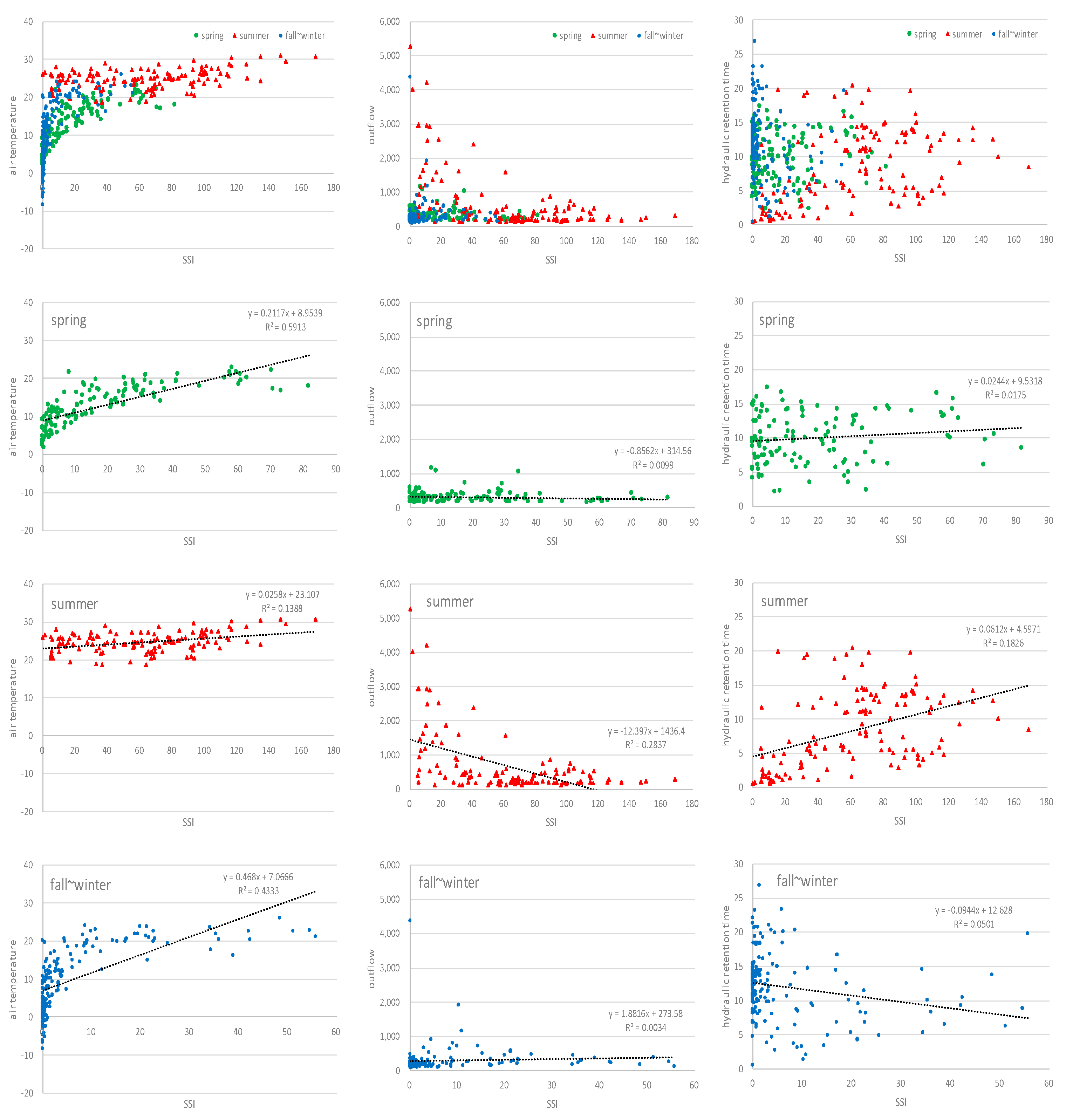


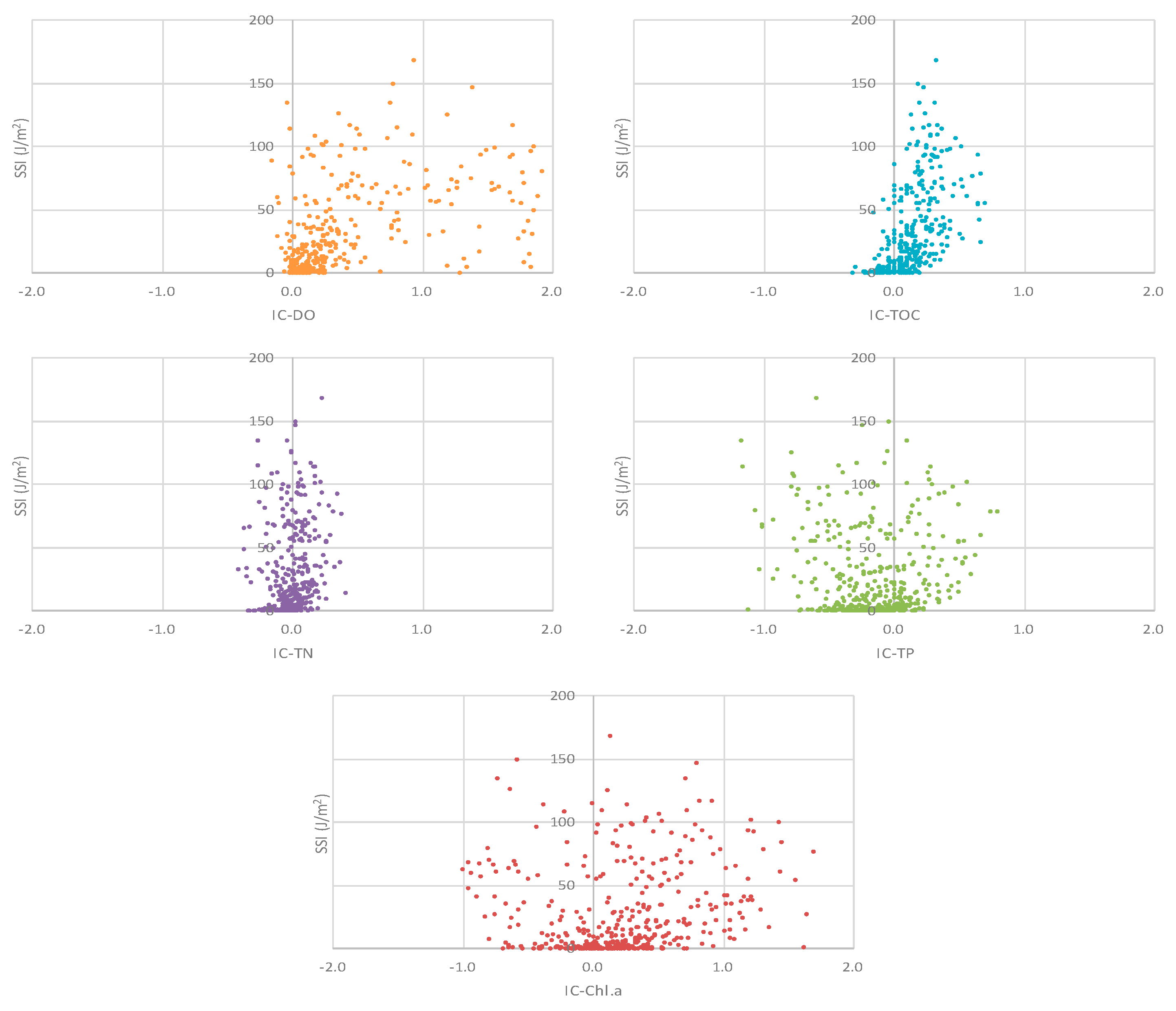
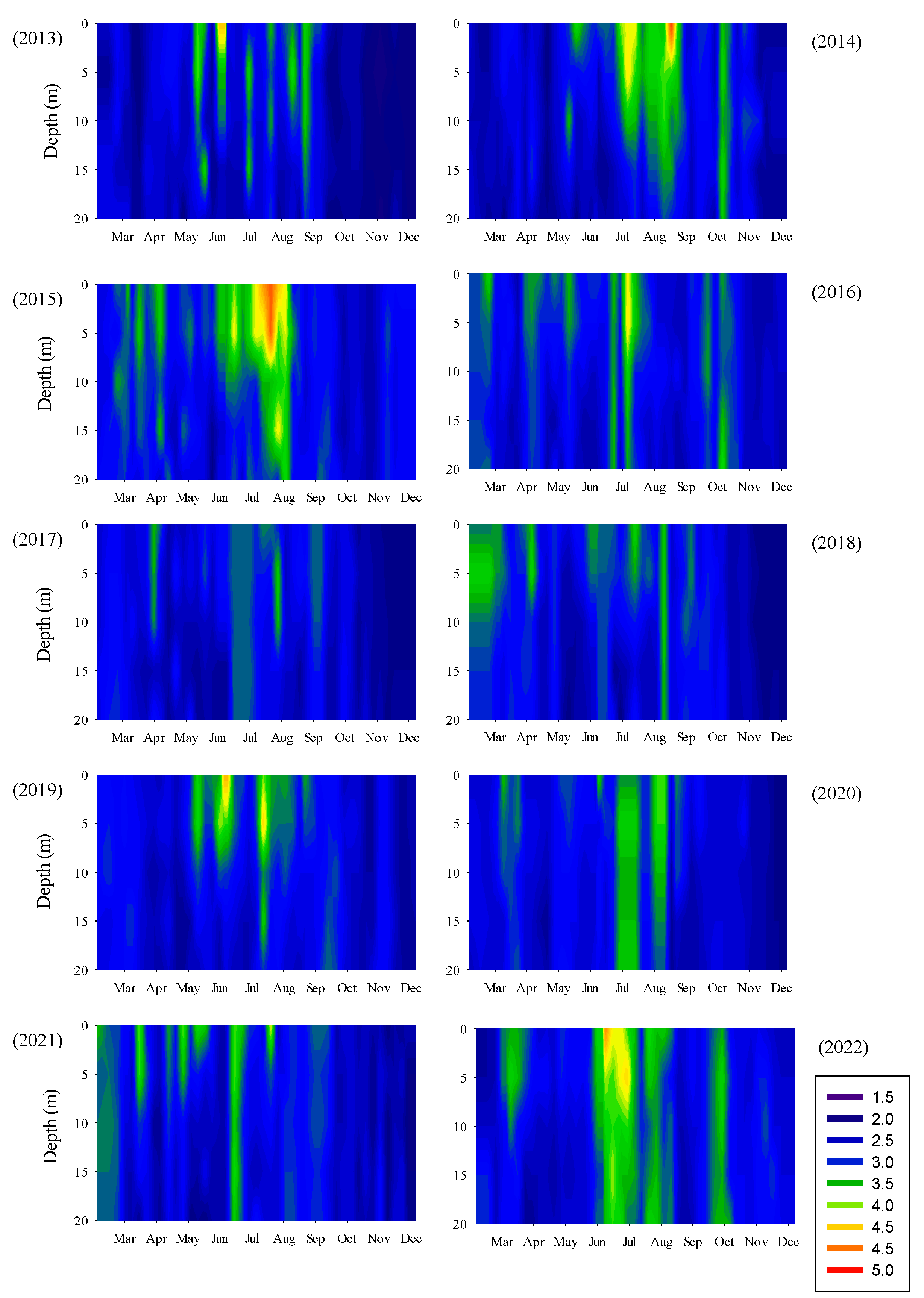
| Longitude | 37°31′17.02″ |
| Latitude | 127°17′00.02″ |
| Total impoundment (106 m3) | 244.0 |
| Effective storage (106 m3) | 18.0 |
| Flood water level (EL.m) | 27.0 |
| Normal high water level (EL.m) | 25.5 |
| Low water level (EL.m) | 25.0 |
| Item | Method | Analysis Equipment |
|---|---|---|
| Water Temperature | - | EXO2, YSI Inc., Yellow Springs, OH, USA |
| Dissolved Oxygen (DO) | Electrode Method | EXO2, YSI Inc., Yellow Springs, OH, USA |
| Total organic carbon (TOC) | High-Temperature Combustion Method | TOC-LCPH Shimadzu, Kyoto, Japan |
| Chlorophyll-α (Chl-α) | - | JP/UV-2600 Shimadzu, Japan |
| Total Nitrogen (TN) | Continuous Flow Analysis | SYNCA Seal Analytical, Tokyo, Japan |
| Total Phosphorus (TP) | Continuous Flow Analysis | SYNCA Seal Analytical, Japan |
| References | Site | SSI (J/m2) | Normal High Water Level (EL.m) | Surface Area (Km2) | Effective Storage (106 m3) |
|---|---|---|---|---|---|
| This study | Lake Paldang (South Korea) | 26.4 | 25.5 | 36.5 | 18 |
| Yu et al., 2010 [26] | Shiozu bay (Japan) | 0–3 | 30 | 23 | - |
| Read et al., 2011 [32] | Lake Rotorua (New Zealand) | 0–150 | 22 | 79 | - |
| Winder and Schindler, 2004 [33] | Lake Washington (USA) | 179.4–237.2 | mean 32.9 maximum 62.5 | 87.6 | - |
| Yoon et al., 2014 [34] | Juam Reservoir (South Korea) | 235.9 | 85 | - | 352 |
| Read et al., 2011 [32] | Lake Annie (Florida, USA) | 0–400 | 19 | 0.37 | - |
| Kling, 1988 [29] | Lake of Cameroon (Africa) | 320–5784 | 301–2227 | 0.08–4.15 | - |
| Sahoo et al., 2015 [35] | Lake Tahoe (USA) | 4000–16,000 | mean 305 maximum 500 | 501 | 158,000 |
| Parameter | All Season | Spring | Summer | Fall~Winter | |
|---|---|---|---|---|---|
| n | 424 | 125 | 128 | 171 | |
| Water temperature | 0.588 ** | 0.764 ** | 0.051 | 0.601 ** | |
| DO | −0.508 ** | −0.702 ** | −0.037 | −0.449 ** | |
| TOC | 0.200 ** | −0.112 | −0.197 * | 0.342 ** | |
| Chl-α | 0.058 | −0.389 ** | 0.142 | 0.360 ** | |
| T-N | −0.451 ** | −0.583 ** | −0.331 ** | −0.196 * | |
| T-P | −0.038 | −0.272 ** | −0.333 ** | 0.186 * | |
| Epilimnion | Water temperature | 0.708 ** | 0.850 ** | 0.596 ** | 0.637 ** |
| DO | −0.091 | −0.461 ** | 0.461 ** | −0.064 | |
| TOC | 0.413 ** | 0.123 | 0.003 | 0.500 ** | |
| Chl−α | 0.138 ** | −0.295 ** | 0.078 | 0.474 ** | |
| T−N | −0.353 ** | −0.470 ** | −0.264 ** | −0.087 | |
| T−P | −0.011 | −0.225 * | −0.343 ** | 0.225 ** | |
| Hypolimnion | Water temperature | 0.471 ** | 0.666 ** | −0.296 ** | 0.570 ** |
| DO | −0.571 ** | −0.705 ** | −0.207 * | −0.529 ** | |
| TOC | 0.054 | −0.264 ** | −0.295 ** | 0.047 | |
| Chl−α | −0.153 ** | −0.489 ** | 0.085 | 0.112 | |
| T−N | −0.507 ** | −0.583 ** | −0.383 ** | −0.278 ** | |
| T−P | −0.024 | −0.240 ** | −0.281 ** | 0.167 * | |
Disclaimer/Publisher’s Note: The statements, opinions and data contained in all publications are solely those of the individual author(s) and contributor(s) and not of MDPI and/or the editor(s). MDPI and/or the editor(s) disclaim responsibility for any injury to people or property resulting from any ideas, methods, instructions or products referred to in the content. |
© 2024 by the authors. Licensee MDPI, Basel, Switzerland. This article is an open access article distributed under the terms and conditions of the Creative Commons Attribution (CC BY) license (https://creativecommons.org/licenses/by/4.0/).
Share and Cite
Son, J.Y.; Han, H.J.; Cho, Y.-C.; Kang, T.; Im, J.K. Seasonal Variations in the Thermal Stratification Responses and Water Quality of the Paldang Lake. Water 2024, 16, 3057. https://doi.org/10.3390/w16213057
Son JY, Han HJ, Cho Y-C, Kang T, Im JK. Seasonal Variations in the Thermal Stratification Responses and Water Quality of the Paldang Lake. Water. 2024; 16(21):3057. https://doi.org/10.3390/w16213057
Chicago/Turabian StyleSon, Ju Yeon, Hye Jin Han, Yong-Chul Cho, Taegu Kang, and Jong Kwon Im. 2024. "Seasonal Variations in the Thermal Stratification Responses and Water Quality of the Paldang Lake" Water 16, no. 21: 3057. https://doi.org/10.3390/w16213057
APA StyleSon, J. Y., Han, H. J., Cho, Y.-C., Kang, T., & Im, J. K. (2024). Seasonal Variations in the Thermal Stratification Responses and Water Quality of the Paldang Lake. Water, 16(21), 3057. https://doi.org/10.3390/w16213057






